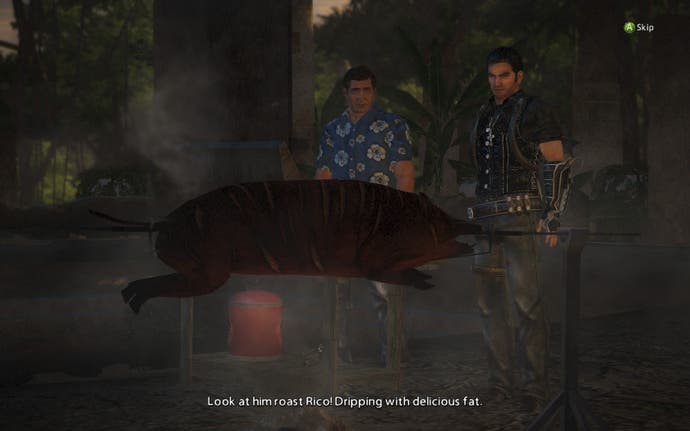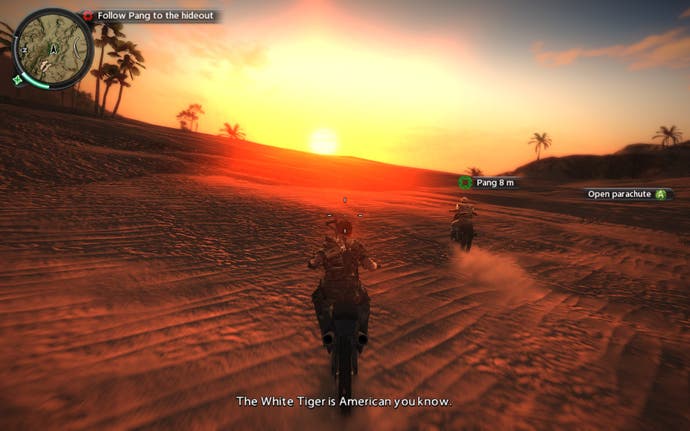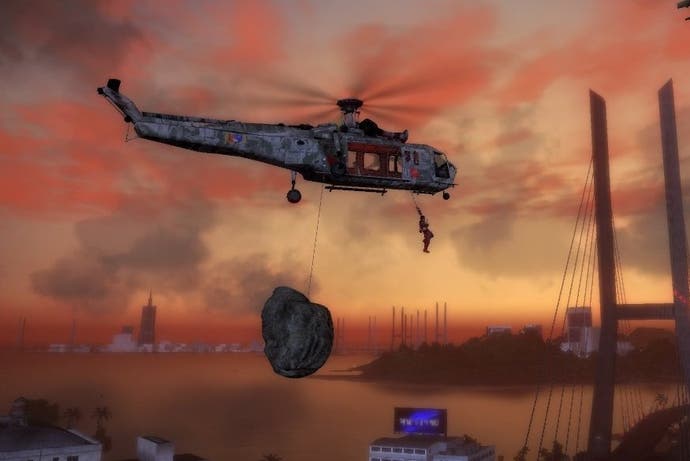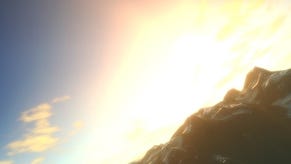Just Cause 2: that rare open-world game where you aren't comically miscast
Vandal hearts.
D.B. Cooper: not his real name. Not even his real fake name, which was Dan Cooper up until the point that the news media mangled it. Cooper's claim to fame - and it is not inconsiderable - is that in 1971 he boarded a commercial jet bound for Seattle, told the cabin crew he had a bomb in his briefcase, and successfully extorted $200,000 from the airline. That's over a million in today's money. Landing at Seattle he collected the cash and four parachutes he had asked for, let the passengers go, and asked the pilots to spin the engines up again and point the plane back the way it came. Half an hour later, he jumped out and has never being heard from since.
What does this have to do with Just Cause 2? Quite a lot, I think, and not just because Avalanche's game is a derring-do affair where skyjacking is a fairly common occurrence. What makes D.B. Cooper's case so interesting - and so relevant - is that he clearly had both savoir faire and a certain degree of expertise. Savoir faire to make the whole grotty business of ransoming seem upbeat and rather dreamy. Expertise that extended to cover the selection of the correct aircraft to skyjack - the Boeing 727, it happens, is an ideal jetliner to jump out of for several dull reasons - but that also ended, rather abruptly, at the question of how to pull off an actual skydive. You'd think that this would be the part of the deal you really wanted to get right. Given four parachutes, Cooper selected an inferior model as his primary chute, and then chose a reserve chute that was clearly sewn shut and would never open. He also parachuted into total darkness and driving rain and fierce winds wearing a flimsy mac and slip-ons, leaping towards the unknown and - presumably - an annoying kind of death stuck at the tippy-top of a fir tree.
There's the connection. Just Cause 2 demands that you approach its madness with a degree of calculation, but also a certain ability to ad-lib. It requires a willingness to be surprised as well as merely delighted. It wants you to be a killer, yet it acknowledges that you will simultaneously be a klutz, Most importantly, although D.B. Cooper is a crook who endangered many lives, it's hard not to find yourself rooting for him. He was polite - he even overpaid for his on-board drinks - and cut a dashing figure right down to his flapping trenchcoat and twinkling tie pin. Just Cause 2's hero, on the other hand, is a hero who often feels like a crook. And that gets to the very heart of this particular game's greatness.
Just Cause 2 is the game where you can tie two objects together. When I first saw it, back in a demo theatre in London many years ago, that was all I could focus on. And it is great, too, this tying-stuff-together business. You can tie an enemy to a gas cannister and puncture it, sending man and cannister into orbit. You can tie a car to a helicopter and use it to knock down trees. You can tie pursuing vehicles to the bridges they pass over as they chase you, creating some memorably dynamic pile-ups.

But tying two things together is actually the second best thing about Just Cause 2. The best thing is the Chaos system. This is an open-world game set in a brutal dictatorship, and that means you have carte blanche, as Rico Rodriguez, a secret agent blown in from out of town, to undermine the dictator in question whenever you get the opportunity. That means trashing his stuff wherever you find it, and a progression system that unlocks new events based on how much damage you've done. And that? That means a sandbox in which you're a vandal rather than a hero: Just Cause 2 is one of the few modern video games in which the player isn't comically miscast.
And it's a video game world that is just itching to be smashed to pieces. Just Cause 2 has a lengthy campaign, with imaginative mission design and a cast of colourful-- well, the mission design is good anyway. I haven't actually played any of these missions in years, mind. The way I play Just Cause 2 these days doesn't really require the intrusion of objectives, or cut-scenes, or any of that jazz. Know what else it doesn't require? Roads. Roads snake all over the state of Panau, and if you set polite waypoints and stick to the tarmac, you'll realise that this is an uncommonly large sandbox in which getting anywhere takes a real investment of time.
The point of all this, of course, is that the game is trying to get you to think beyond roads. Drive like a vandal! Faced with a back-and forth hairpin, neatly stacked down the side of a pretty mountain, the correct response is actually to drive straight across it, leaping from bend to bend to bend until you've hit the bottom of the valley and are bouncing your way up the other side. The road itself should be a cameo appearance, or a series of cameos, as pedestrians scatter and fencing is splintered. This approach cuts down travelling time and also provides loads of decent army vehicles to hijack as you race along, kiting law enforcement. It also lets you drop in, unexpectedly - particularly unexpectedly to you! - on out-of-the-way military facilities to blow up, hauling in even more precious chaos.

Tell you what, why bother with driving at all? Allow me to let you in on a terrible Just Cause 2 addiction I have, to a snub-nosed single-seater jetplane called the Pell Silverbolt 6. I love these things. I spawn them every few minutes, and then discard them like old drinks cartons, reaching for another moments later when the mood takes me. And the mood always takes me. The sense of thrust is completely energising: the Silverbolt 6 needs almost no runway before you're up in the air, and then you can chase clouds, thread between the passing spars of a bridge, and zoom in low over the water. It also looks the part, like a Groom Lake deniable asset, dark and strange and probably designed by the Horten Brothers.
The worst thing about the Pell Silverbolt 6 is that it doesn't have a gun on it. The best thing about the Pell Silverbolt 6, however, is that it doesn't have a gun on it. That means that when you're strapped in and soaring through the skies, you have no reticule to distract you, no possible extrinsic reward you could - and therefore should - be netting. You're free! Free to be a tourist and to gawp at one of the most beautiful video game worlds ever created: sunset beaches, frosty mountains hedged with secret military installations, jungles and archipelagos, one of whose islands houses, apparently, a nod to the TV show Lost.
Still, chaos is never far away in Just Cause 2. Here's another thing the Pell Silverbolt 6 doesn't have: reverse. That means when you get one dropped off by the black market, you need to be extra sure you have enough clear horizon ahead of you to actually get aloft. When you don't, things become amusing. Careening along the ground, upside down in a flaming superjet: that's any open-world game, but Just Cause 2 adds wrinkles as you employ other vehicles - a bike, say - to drag your precious throw-away jet into a better position. If the bike's too gutless, once you reach the end of the cable, you just fly over the handlebars as the Pell's superior weight reasserts itself. Sometimes, you actually end up dragged along in the runaway jet's wake, if you were foolish enough to spawn it on an incline. I'm a conscientious man, so I only ever spawn Pell Silverbolts on freeways, beaches, and busy city intersections. What could go wrong? Still: once, my upside-down jet magically managed to get some lift as it raced towards a wall. It hit the wall at an awful angle and spun up, arcing into the air, burping me out onto the gravel behind it as it corkscrewed away and eventually landed in a distant tuc-tuc. That's Just Cause 2. The beauty of the warped parabola!
The genius, of course, is that even if you do play through the missions, Just Cause 2 retains a little of its beauty, and a lot of its chaos. It helps, in this capacity, because like its predecessor, the game is delightfully rough around the edges. Early on, for example, your job is to rattle your way up a broadcasting tower and blow up the dish. When you do, though, and you're freefalling to safety through the thicket of a debrief screen, you may just glimpse a catastrophe occurring, as the dish itself, now detached, but still very much a physics object, crashes into you, causing a classic Just Cause 2 instadeath. Equally, it's not uncommon to hijack a passing vehicle, land behind the wheel and discover you've nabbed yourself a real dog of a car, throatless, whining, with steering that drifts into trees. Terrible vehicles as the norm in an open-world game should be the very worst kind of sin, but here, they feel more like a punchline. Nice move, sucker. Was it worth it?
Perhaps this is why I bounced off the multiplayer mod, a beautiful piece of work that brought an aging classic back to life for many people who played it - and a sign that occasionally a publisher knows when the modding community is genuinely doing it a massive favour. I had a lot of fun in my time in multiplayer Just Cause 2, of course, but something felt off. You know how in the old comic book movies, there can only be one hero? In my Panau, there can only be one vandal. After all, look at the people who tried to follow in D.B. Cooper's footsteps over the years: no class, no mystery. Turns out anybody can jump from an airliner with a bag of money. Doing it with flair, though? That's something pretty unusual.
FWIW, I really enjoyed Skyjack: The Hunt for D. B. Cooper by Geoffrey Gray. I think it's out of print, but you can pick it up very cheap online.









